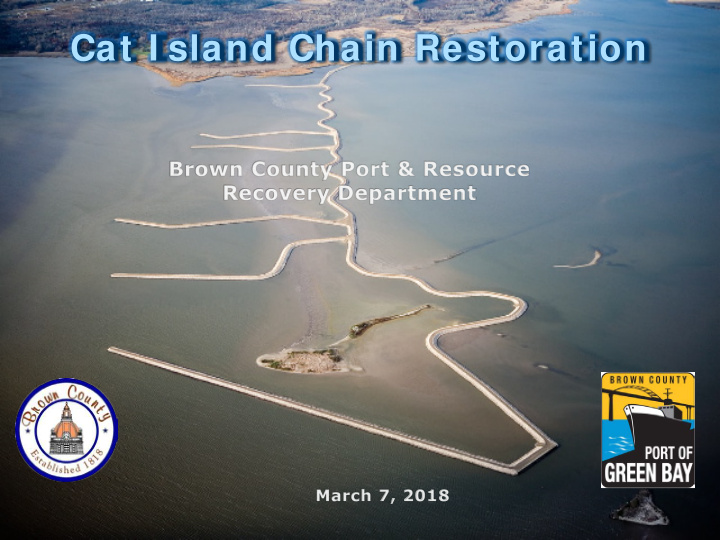



Cat I sland Chain Restoration
1845 Chart of Green Bay & Fox River 1820s Fox River Military Road Map to Fort Howard
Cat Island Chain - 1938 Cat Island Brown County Aerial Photography, 1938
Historic Western view of lower Green Bay • Expansive emergent marshes (e.g. Duck Creek delta, Peats Lake) • Numerous small islands • Beaches and mud flats • Submerged aquatic plant beds Photo Courtesy of Tom Erdman, 1966
Bass Islands Willow Island Lone Tree Island Cat Island Grassy Island 1966 during low water levels Islands extend 2.5 miles into Green Bay Photo Courtesy of Tom Erdman, 1966
Little Tail Point Long Tail Point Peter’s Marsh Cat Island Chain Duck Creek Delta Rock dikes hardened the shoreline Municipal incinerator and landfill Photo Courtesy of Tom Erdman , 1970
Long Tail Point Cat Island Bass Islands Duck Creek Delta Marsh Landfill 90% of Coastal Wetlands I-43 Construction Lost from Southern Green Bay Agriculture Photo by WDNR, 1969
Cat Island Chain – 1960-2010
Project Beginning The Cat Island Chain project developed out of the 1988 Lower Green Bay Remedial Action Plan (RAP) and was the top priority project for habitat restoration. Members of the Citizens Advisory Committee and DNR staff worked together to develop the Lower Green Bay Remedial Action Plan. (Photo by Dave Crehore)
Cat Island
Green Bay Shipping Channel
Annual Dredging Annual maintenance dredging is necessary to keep the Port of Green Bay active Annual dredging of 100,000 to 250,000 CY of sediment that has settled into the 14 mile long navigational channel
Project Goals Restore diversity of island and aquatic habitats Recreate 1960s island “footprint” Enhance spawning and nursery grounds for various fish species (e.g. yellow perch, musky, pike, walleye, sunfish) Create disposal capacity Beneficially use dredged material from the maintenance of the Port of Green Bay Photo by WDNR 1969
Project Partners Partnership between: Brown County, WDNR, WDOT, US Fish & Wildlife Service US Army Corps of Engineers, USEPA, UW-Sea Grant, UW-Green Bay Port Operators and the Fox River Group of paper mills Cat Island Advisory Committee (CIAC) Citizen Member
Lake Bed Grant
Construction Phase I - June 2012 Cat Island Brown County Aerial Photography , 2012
Construction Phase II - October 2012 December 17, 2012
May 16, 2013 Tons ($) Gravel 41,788 $ 158,379 Core Stone 504,411 $ 1,743,609 Armor Stone 161,666 $ 1,611,829 Total 707,865 $ 3,513,817 Approx. 34,000 truckloads November 12, 2013 95% Complete
Project Costs Original Actual $ 34,190,889 $ 19,281,931 Project Cost Less Brown County GLRI Grant $ 1,500,000 $ 1,450,053 Total Project Costs $ 32,690,889 $ 17,831,878 65% Federal Share $ 21,249,078 $ 11,182,838 35% Non-Federal Share $ 11,441,811 $ 6,649,040 Total Project Costs $ 32,690,889 $ 17,831,878 Non-Federal Funding Sources $ 7,141,835 $ 5,319,232 WDOT Harbor Assistance Grant NRDA Funds $ 800,000 $ 800,000 Terminal Operator Harbor Fees $ 499,000 $ 529,808 Brown County $ 336,459 $ - Brown County In-Kind $ 150,000 $ - $ 8,927,294 $ 6,649,040 Total Non-Federal Funds $ 8,172,722 $ 4,457,970 25% Non-Federal In-Kind Contribution 10% Non-Federal Cash Contribution $ 3,269,089 $ 1,783,188
Sediment Disposal Area Storage Years Remaining Island (acres) Capacity (assume 2 yr cycles and sequential filling) (yards 3 ) West Island 74 900,000 8 Central Island 92 1,140,000 22 East Island 106 1,680,000 40 Only outer harbor “clean sediments” will be placed onto the islands
September 9, 2014
May 7, 2015
July 2, 2015
October 24, 2016
October 26, 2016
April 21, 2017
Habitat Impacts Colonial Nesting Water Birds Shorebirds Waterfowl Fish Spawning Fish Nurseries Turtles Amphibians Invertebrates
Importance of the area Interior sites gaining recognition for importance Lower Green Bay identified as important shorebird staging area 35 species reported via eBird in Wisconsin portion of Green Bay American Avocets
Cat Island Habitat Projects Tern Platforms Plantings and Plover Monitoring Habitat Brown County Aerial Photography, 2017
Piping Plover Piping Plover successfully bred on westernmost island in 2016 & 2017 • First local breeding in 75+ years
Tern Platforms
Wild Rice Planting Courtesy UWGB, 2015, 2016
FY17 Dredging Activities Rear Barrier placed in center cell 38,500 CY to Cat Island (100,000 to be placed in 2018) 84,293 CY from transition area to Bay Port Cell 5
On-Going Issues Management Cat Island Advisory Committee (CIAC) Public Access Public Safety Sensitive Wildlife Habitat Area Filling Sequence and Timing Removal of Causeway
Public Access
November 8, 2017
2017 CENTER CELL BARRIER INSTALLATION Approximately 2300 LF of geotextile lined gabion-style barrier placed across the back of the center island
Barrier Construction Barrier
Cat Island Chain - 2017 Cat Island Brown County Aerial Photography, 2017
Project Outcomes 30-50 years worth of disposal capacity Beneficial reuse of dredged material 2.5 mile wave barrier and re-establishment of 272 acres of islands Wave barrier protecting 1,225 acres and providing critical habitat for birds, fish and mammals Improved water clarity increasing weed grown for fish spawning and serving as a nursery and improved migratory bird sanctuary/lay over
Questions? Mark Walter Brown County Port & Resource Recovery Department
Recommend
More recommend